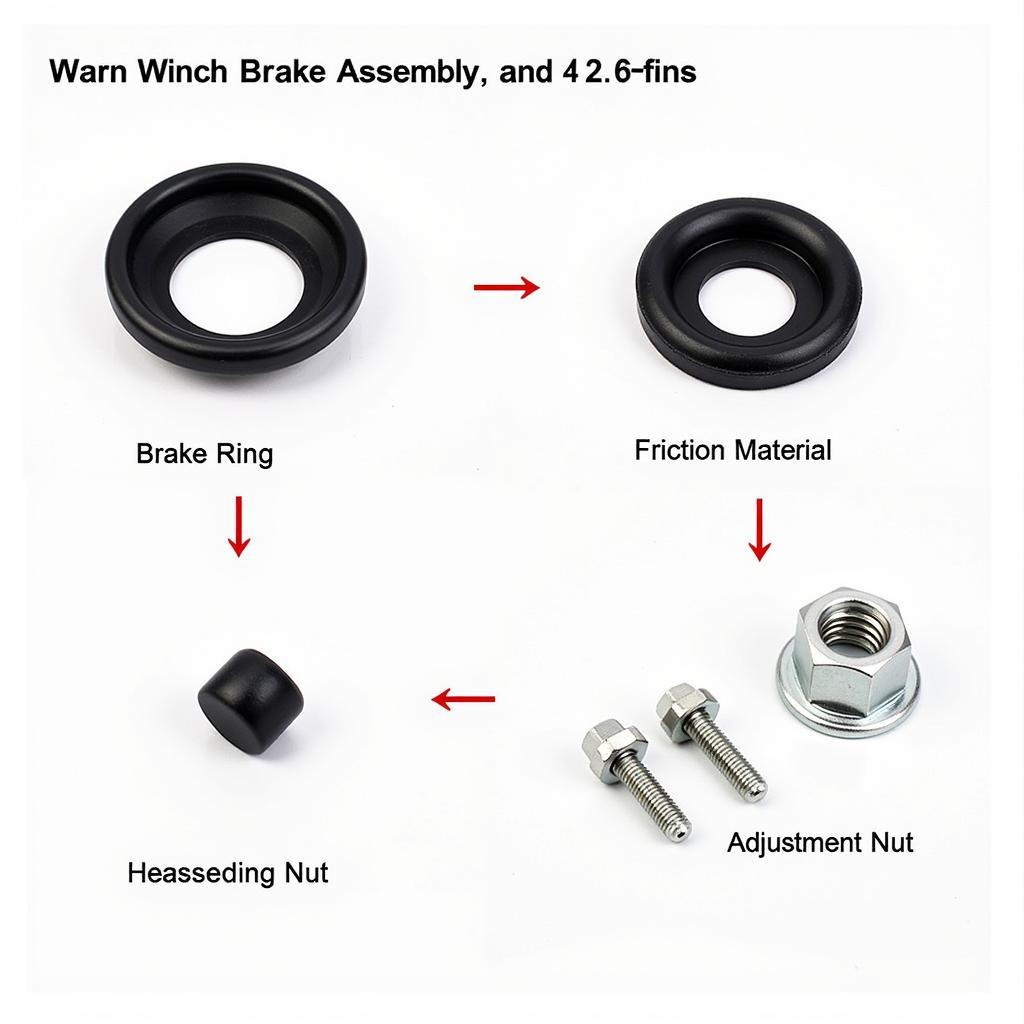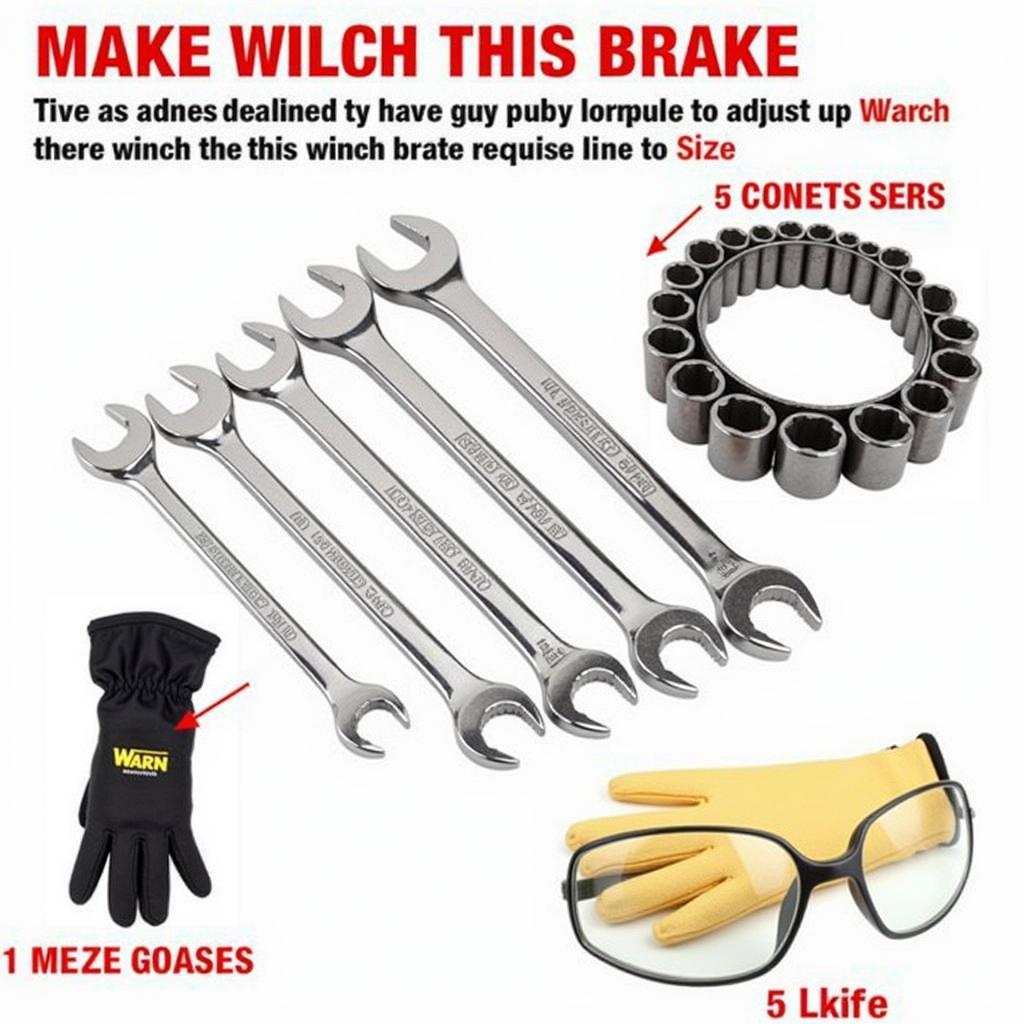A malfunctioning winch brake can be a major safety hazard, potentially leading to uncontrolled unwinding and dangerous situations. If you’re experiencing issues with your Warn winch brake, specifically needing adjustment, this guide will provide you with the knowledge and steps to address it effectively.
Let’s dive into the intricacies of the Warn winch brake system and explore the adjustment process step-by-step.
Understanding Your Warn Winch Brake
The brake system on your Warn winch is a critical safety component, designed to hold the load securely even when the winch is not under power. It typically consists of a spring-loaded brake mechanism that engages automatically when the winch drum stops rotating.
 Warn Winch Brake Components
Warn Winch Brake Components
Common Signs of Brake Issues
Recognizing the signs of a faulty winch brake is crucial for timely intervention. Here are some common indicators:
- Uncontrolled unwinding: The most obvious sign, your winch drum may release the load unexpectedly, even without activating the winch controls.
- Unusual noises: Grinding, clicking, or squealing sounds during winching or when releasing the load might indicate brake problems.
- Difficulty holding a load: If your winch struggles to maintain a static load or the load slowly slips downward, your brake needs attention.
Warn Winch Brake Adjustment: A Step-by-Step Guide
Before you begin, remember that working with mechanical components requires caution. Ensure the winch is disconnected from the power source and follow all safety precautions outlined in your Warn winch manual.
 Warn Winch Brake Adjustment Tools
Warn Winch Brake Adjustment Tools
Here’s a general guideline for adjusting your Warn winch brake. Please note that specific procedures may vary slightly depending on your winch model. Always refer to your winch’s user manual for the most accurate instructions.
- Locate the adjustment nut: The brake adjustment is typically located on the end of the winch drum, often concealed by a cover or a cap.
- Loosen the lock nut: You’ll find a lock nut securing the adjustment nut. Use a wrench to loosen the lock nut while holding the adjustment nut in place.
- Adjust the brake: Turn the adjustment nut in small increments. Tightening the nut increases the brake tension, while loosening it reduces the tension.
- Test the adjustment: After each adjustment, test the brake by manually pulling out some cable. The brake should engage firmly and hold the load.
- Secure the lock nut: Once you achieve the desired brake engagement, tighten the lock nut securely against the adjustment nut to prevent it from loosening during operation.
- Double-check your work: Perform a final test by winching a load and verifying that the brake holds firmly.
Tips for Effective Brake Adjustment
- Small adjustments are key: Make incremental adjustments to the brake. Over-tightening can lead to premature wear and tear.
- Consult your manual: Always refer to your specific Warn winch manual for the correct adjustment procedure and specifications.
- Safety first: Wear safety glasses and work gloves to protect yourself during the adjustment process.
- Seek professional help: If you’re uncomfortable or uncertain about any aspect of the adjustment, don’t hesitate to seek assistance from a qualified Warn winch technician.
Troubleshooting Persistent Brake Problems
If adjusting the brake doesn’t resolve the issue, further troubleshooting might be necessary. Some potential causes of persistent brake problems include:
- Worn brake components: Friction surfaces within the brake mechanism can wear out over time, requiring replacement.
- Damaged or contaminated brake parts: Inspect the brake components for any signs of damage, debris, or lubricant contamination.
- Internal winch issues: In some cases, the problem might stem from internal issues within the winch itself, requiring professional diagnosis and repair.
Maintaining Your Warn Winch Brake
Proper maintenance is essential for optimal winch performance and longevity. Here are some maintenance practices:
- Regular inspection: Periodically inspect the brake components for wear and tear, damage, or looseness.
- Cleaning: Keep the brake area free of dirt, debris, and lubricant buildup, which can interfere with brake function.
- Lubrication: Apply the recommended lubricant to moving parts of the winch as per the manufacturer’s instructions. Avoid getting lubricant on the brake surfaces.
Conclusion
A properly functioning Warn winch brake is crucial for safe and reliable winching operations. Understanding how to adjust and maintain your winch brake empowers you to address potential issues promptly and confidently. Remember to prioritize safety, follow the manufacturer’s guidelines, and seek professional assistance when necessary. By taking these steps, you can ensure that your Warn winch continues to be a dependable tool for years to come.
